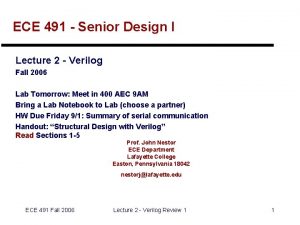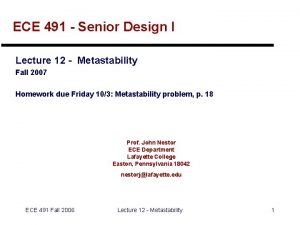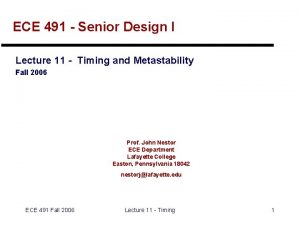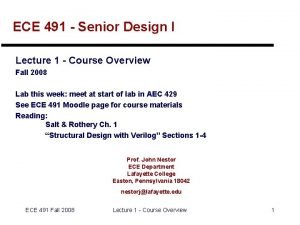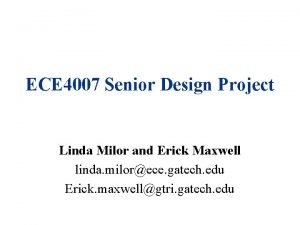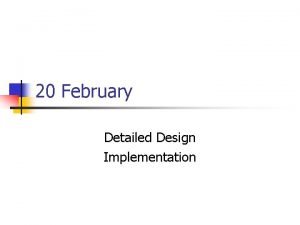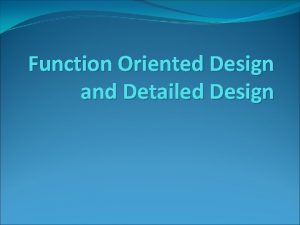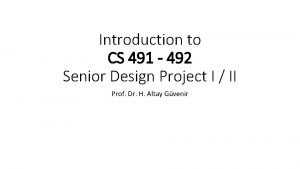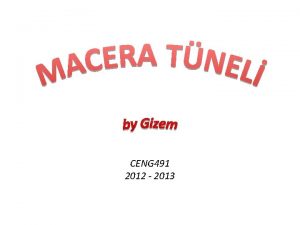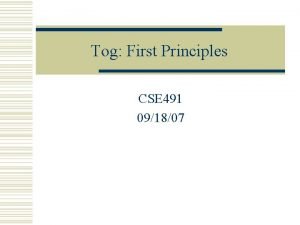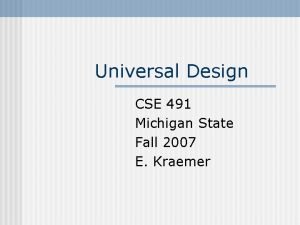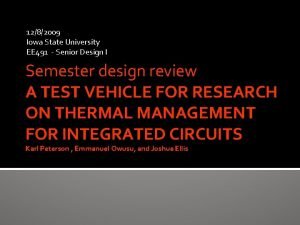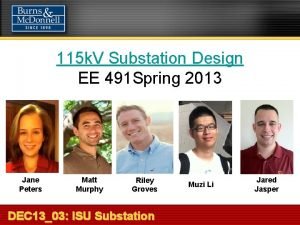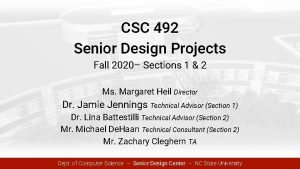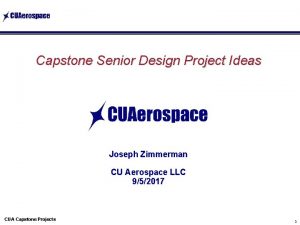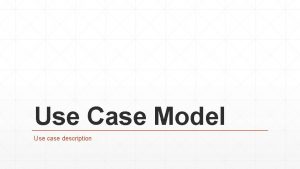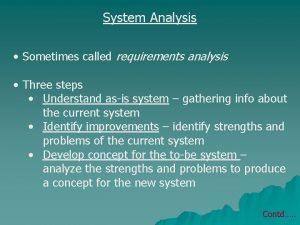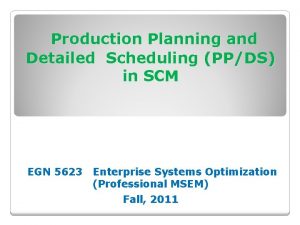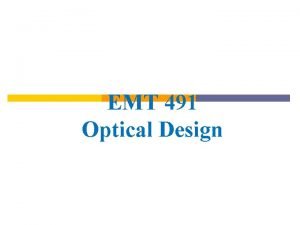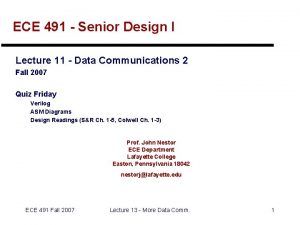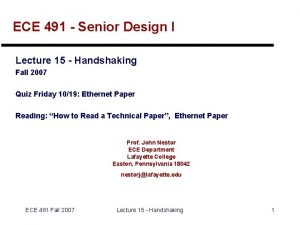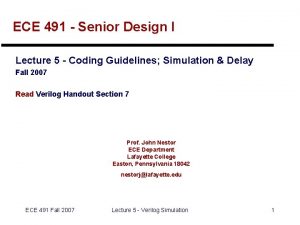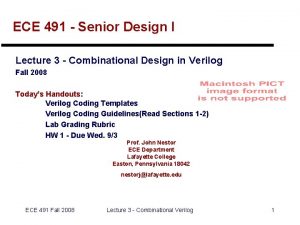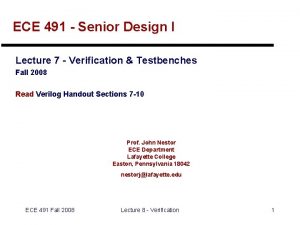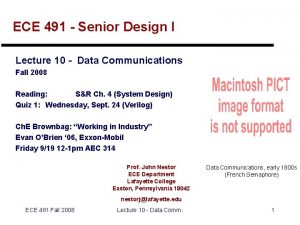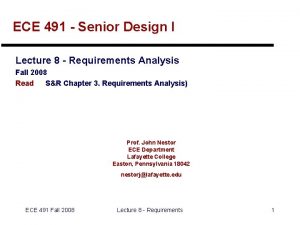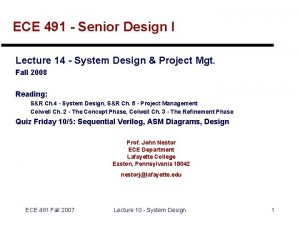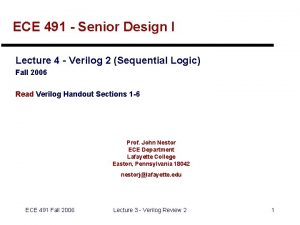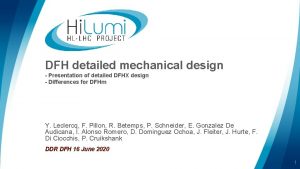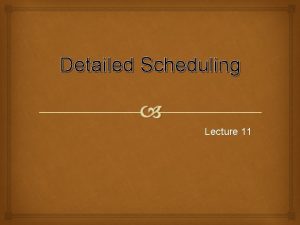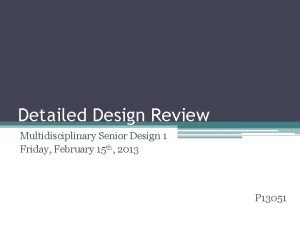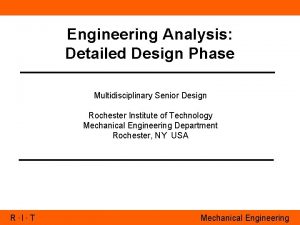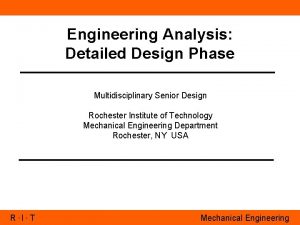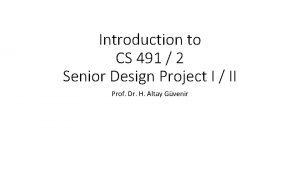ECE 491 Senior Design I Lecture 13 Detailed























- Slides: 23

ECE 491 - Senior Design I Lecture 13 - Detailed Design Fall 2007 Reading: Colwell, Ch. 3 -4, “Design Reviews” Salt & Rothery Chapter 5, 6 Prof. John Nestor ECE Department Lafayette College Easton, Pennsylvania 18042 nestorj@lafayette. edu ECE 491 Fall 2005 Lecture 13 - Detailed Design 1

Where we are } Last Time: } Metastability } Today: } Detailed Design ECE 491 Fall 2005 Lecture 13 - Detailed Design 2

Detailed Design Overview BLOCK A: Detailed Design Implementation Debug and verify System Spec. BLOCK B: Detailed Design Implementation Debug and verify Project Plan System Integration And Test Prototype BLOCK J: Detailed Design Implementation Debug and verify Req. Spec Test Plan S & R Fig. 6. 1 ECE 491 Fall 2005 Lecture 13 - Detailed Design 3

Block Design Activities Manufacturing BLOCK A: Detailed design documentation System Spec. Project Plan Detailed design Implementation Debug & verification System integration And test S & R Fig. 6. 2 ECE 491 Fall 2005 Lecture 13 - Detailed Design 4

Testing & Verification Cost of fixing flaws } Key to successful design } Finding bugs early is key During design ECE 491 Fall 2005 During manufacturing After sale Lecture 13 - Detailed Design S & R Fig. 6. 4 5

Testing & Verification } Unit test – done during detailed design } Verify that blocks work correctly “standalone” } Allow for regression testing after design changes } System test – final test after integration } Often a formal event } Requires a detailed System Test Plan ECE 491 Fall 2005 Lecture 13 - Detailed Design 6

Design Management } Communications during design } Goal: reduce communication to allow independent block designs } Reality: some communication is necessary } Documentation } Key documents: schematics, HDL code, “theory of operation” document } Revision control – to keep documentation consistent and up to date } Design Reviews – to report on design progress and examine design decisions ECE 491 Fall 2005 Lecture 13 - Detailed Design 7

Colwell Ch. 3 - Refinement (cont’d) } } } Engineering Change Orders (from last time) The Bridge from Architecture to Design Product Quality - covered in Verification Design Reviews Anecdote: the P 6 Bus ECE 491 Fall 2005 Lecture 13 - Detailed Design 8

Engineering Change Orders (ECOs) } A way of tracking and managing design changes } Original form: “piece of paper” with approval signatures } Current: web-based or email-based } Sources of Change: } } Marketing / Management Performance Analysis Functional Validation Design Complexity Issues ECE 491 Fall 2005 Lecture 13 - Detailed Design 9

Managing ECOs } Start in Concept phase by documenting key ideas and decisions; communicating to others } Begin ECOs after behavioral model is designed } “ECO Czar” - responsible for tracking ECOs and keeping documents up to date } Approval process: signature list ECE 491 Fall 2005 Lecture 13 - Detailed Design 10

The Bridge from Architecture to Design } How do you transfer “core ideas from the heads of the architects into the heads of the design team? ” } Must transfer “philosophy” - ot just what is to be designed, but why? } Challenge: establishing trust with design team when unknowns persist } P 6 project used a library of video presentations } Focus Groups as a method of transfer ECE 491 Fall 2005 Lecture 13 - Detailed Design 11

Design Reviews } Goals of design review } Keep members of team up to date about state of design } Keep stakeholders up to date about state of design } Provide designer with feedback about key decisions ECE 491 Fall 2005 Lecture 13 - Detailed Design 12

Bell Labs Software Design Reviews } Presenter makes design materials available to reviewers in advance: } } Background information Relevant parts of design specification Source code Testing plans and status } Reviewers must study these materials in advance } Designer gains benefit from preparation ECE 491 Fall 2005 Lecture 13 - Detailed Design 13

Ingredients for a Successful Review } Collwell: Attitude is key } Both reviewer and designer must “distance themselves emotionally from the design under review” } “As a design engineer leading a design review, your job is to … put your ego in your desk drawer and present your design for review by smart people who are motivated to find things wrong with it” } “keep reminding yourself that the reviewers are seeking flaws in your design – not flaws in you” } “…someday you will have occasion to return the favor” ECE 491 Fall 2005 Lecture 13 - Detailed Design 14

Design Anecdote - The P 6 Bus } The Question } P 6 group designed a new bus } Original Pentium bus designers wanted P 6 to use their bus } Issues } New bus accounted for widening gap between processor clock and memory speed } But, new bus would require redesign of system logic, motherboards, etc. } How was the decision made? } Technical considerations vs. political considerations ECE 491 Fall 2005 Lecture 13 - Detailed Design 15

Colwell Ch. 4 - Realization Phase } Goal: build the design selected in Refinement } Large increase in number of participants } Time to commit and “burn the lifeboats” “Nothing will ever be attempted, if all possible objections must first be overcome” --Samuel Johnson } Result of realization: a prototype } Analogy: construction phase for a large building ECE 491 Fall 2005 Lecture 13 - Detailed Design 16

Realization Phase: Success Factors } Balanced decision making - who makes the call on design decisions? } Can’t consult architect for every decision - too many! } The “ 1% rule”: “If you believe that the performance impact of the choice is less than 1% on the designated benchmark, you are free to make the choice on your own. Higher than a 1% performance hit and you must include architects in the decision” } Documentation - “Microarchitecture Specifications” } Integrating architects and design engineers ECE 491 Fall 2005 Lecture 13 - Detailed Design 17

Performance/Feature Tradeoffs } Pitfall: “over-optimizing” performance “The best is the enemy of the good” --Voltaire } Reliability concerns } The need for error detection } What should happen when an error occurs? • Roll-back? • Restart? } Performance-monitoring facilities } Pitfall: “gratuitious innovation” ECE 491 Fall 2005 Lecture 13 - Detailed Design 18

Managing Realization } Metrics needed to track design progress } “Health of Model” Metric } } } Regression results Time to debug Forward progress High-priority bugs Age of bugs } Pitfall: many bugs are found in late stages of design; metric may get worse towards end ECE 491 Fall 2005 Lecture 13 - Detailed Design 19

Managing Realization } Awards, Rewards, and Recognition } A motivation tool for high performance } Pitfalls: • • Overlooking important achievements Giving credit to the wrong persons Not considering the larger context “Firefighting by arsonists” ECE 491 Fall 2005 Lecture 13 - Detailed Design 20

Managing Realization } Adding headcount doesn’t always help } New staff must be brought up to speed } But, may be useful in well-defined tasks “Adding manpower to a late software project makes it later” -- F. Brooks, “Brooks’ Law” ECE 491 Fall 2005 Lecture 13 - Detailed Design 21

Scheduling and Project Tracking } Predicting a schedule is difficult } Large amount of uncertainty } Make “best guess” based on experience } Use for high-level planning (project costing, staffing, etc. ) } Project Tracking } P 6 approach: Weekly report from engineers • Estimate how much of assignment is accomplished • Estimate how much time remains • See curves in Fig. 4. 1, 4. 2, 4. 3 pp. 107 -110 ECE 491 Fall 2005 Lecture 13 - Detailed Design 22

Coming Up } Handshaking to synchronize multiple FSMs } Intellectual Property } Ethernet ECE 491 Fall 2005 Lecture 13 - Detailed Design 23
 Ece 491
Ece 491 Ece 491
Ece 491 Ece 491
Ece 491 Ece 491
Ece 491 Ece senior design gatech
Ece senior design gatech Detailed design in software engineering
Detailed design in software engineering Detailed design software
Detailed design software 01:640:244 lecture notes - lecture 15: plat, idah, farad
01:640:244 lecture notes - lecture 15: plat, idah, farad Ba491
Ba491 External analysis in strategic management
External analysis in strategic management Pd 491
Pd 491 Cs 491 bilkent
Cs 491 bilkent Bahri tokmak
Bahri tokmak Cse 491
Cse 491 Cse 491
Cse 491 Ee 491
Ee 491 Ee 491
Ee 491 Senior design ucf
Senior design ucf Ncsu csc senior design
Ncsu csc senior design Ee senior design project ideas
Ee senior design project ideas How to write use cases
How to write use cases Detailed analysis sometimes is called
Detailed analysis sometimes is called Reading for detail
Reading for detail Product planning and detailed scheduling
Product planning and detailed scheduling
